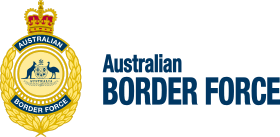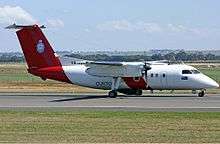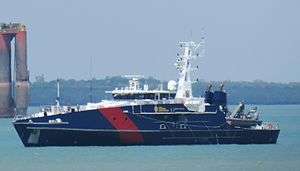Australian Border Force
| Australian Border Force | |
|---|---|
 Logo of Australian Border Force | |
| Abbreviation | ABF |
| Agency overview | |
| Formed | 1 July 2015 |
| Preceding agencies |
|
| Employees | 5,800[1] |
| Annual budget | A$116 million (2016) |
| Jurisdictional structure | |
| Federal agency | AU |
| Operations jurisdiction | AU |
| General nature | • Federal law enforcement |
| Headquarters | Belconnen ACT 2617 |
|
| |
| Elected officer responsible | |
| Agency executive |
|
| Parent agency | Department of Home Affairs |
| Website | |
| https://www.abf.gov.au | |
The Australian Border Force (ABF), is a part of the Department of Home Affairs, responsible for offshore and onshore border control enforcement, investigations, compliance and detention operations in Australia. The Force was established on 1 July 2015 merging the Australian Customs and Border Protection Service with the immigration detention and compliance functions of the then Department of Immigration and Border Protection.
The ABF is a law enforcement agency operating under the Australian Border Force Act 2015 with broadened legislative powers including the introduction of sworn officers.[2] A new uniform was introduced and following the transition there was an increase in the number of officers authorised to carry firearms.[3][4] As of 2016, approximately 15% of the Force is firearms trained which will increase by 2020 to less than 25%.[1]
Immigration and Border Protection Minister Scott Morrison announced the establishment of the Force on 9 May 2014 to be based on a hybrid of the United Kingdom Border Force model.[5][6][7]
History
The National Commission of Audit recommended the merger in February 2014.[7] The Australian Border Force Bill 2015 was introduced on 25 February 2015 and passed on 14 May 2015.
Organisational structure
The ABF has approximately 5800 employees across operational and support roles divided into an Operations Group and an Support Group.[1]
Operations Group
The Operations Group has responsibilities for all operational activity relating to the management of travellers, goods and cargo throughout the border continuum. The Operations Group consists of the following commands:
- The Port Operations Command oversees all border protection operations at port of entry and international gateways including international airports, sea ports and international mail gateways across the state and territories of Australia through regional sub-commands. From September 2014, Counter Terrorism Units (CTU) were operating in all major international airports, who from December 2014 were granted authority to carry firearms in airports, to intercept travellers who are departing to join terrorist organisations in conflict zones such as Islamic State and to intercept returning members of terrorist organisations such as fighters.[8]
- The Border Patrol and Coordination Command provides 24/7 operational coordination capability to the ABF in collaboration with regional and international law enforcement and defence partners and houses the Australian Border Operations Centre (ABOC). The Border Patrol and Coordination Command is also responsible for border protection efforts across Northern Australia alongside the Australian Defence Force Northern Command.[9]
- The Enforcement Command is the criminal investigations and field operations command of the ABF responsible for investigating and enforcing Australian customs and immigration laws and combating transnational organised crime within the borders of Australia.
- The Maritime Border Command a multi agency task force with the Australian Defence Force responsible for civil maritime security and coast guard activities.[10][11]
Support Group
The Support Group has responsibility for providing planning, support and specialist services to ensure operational continuity across the border continuum and the operational management responsibility for detention services management including health, detention estate management, and regional processing and settlement.[12] The Support Group includes the following commands:
- The Strategic Border Command provides strategic coordination for the ABF including ministerial and parliamentary services, international liaison, and governance oversight.
- The Operational Practices Command is responsible for personnel management, workforce development, and education and training including the Australian Border Force College.
- The Close Support Command develops the marine, aviation, and tactical capabilities of the ABF including surveillance, forensics and the Detector Dog Program.
- The Detention and Offshore Operations Command provides immigration detention services including the regional processing and resettlement program.
Major operations
- Operation Sovereign Borders - A joint agency operation introduced to minimise the amount of unlawful maritime arrivals and people smuggling into Australia's border.
- Taskforce Cadena - The Australian Government established Taskforce Cadena in June 2015 to target and disrupt the criminals organising visa fraud, illegal work and the exploitation of foreign workers.
- Operation Fortitude - A visa checking operation was held in Melbourne in August 2015, Operation Fortitude.[13] It was cancelled following protests and community concern that racial profiling would take place.[14] In addition, concerns were raised over the immigration system's "militarisation".[15] On the day of Operation Fortitude's launch, over 200 protestors converged on Flinders Street railway station in Melbourne, at the same time as Operation Fortitude was officially launched by the ABF and Victoria Police.[16] In October 2015, talking points released by the ABF revealed that the focus of the exercise would have been taxi ranks.[17]
Passenger profiling and watchlists
The Australian Border Force uses a "big data" analysis ecosystem to monitor people and cargo entering and leaving Australia. This includes the use of machine learning capabilities across a range of analytical platforms that draw together multiple data sources to provide insights.
The Central Movement Alert List (CMAL) is an electronic watch list, containing information about individuals who pose either an immigration or national security concern to the Australian Government as well as information on lost, stolen or fraudulent travel documents. CMAL comprises two databases, the Person Alert List (PAL) and the Document Alert List (DAL). The PAL database stores the biographical details of identities of concern and DAL is a list of lost, fraudulent or stolen travel documents. PAL records are categorised according to the reason for listing the identity—the alert reason code (ARC). There are 19 ARCs with each being categorised as high, medium or low risk.
Australian Members of Parliament have expressed concerns about the lack of systematic control over data input and maintenance of the Alert List, stating that Australian citizens and visitors may suffer inconvenience or harassment due to misinformation or incorrect information being entered into the system.[18]
The Australian Border Force receives Passenger Name Record data from airlines operating into and out of Australia. PNR data is information about passengers that is held by airlines on their computer reservation system. PNR data includes approximately 106 different fields such as passenger name(s), sex, passport number, nationality, travel companions, frequent flyer Information, date and place of ticket issue, contact phone numbers, credit card number and expiry date, number of bags, seat allocation, and the passenger's full itinerary.[19]
Personnel
Commissioners

| Rank | Name | Post-nominals | Term began | Term ended |
|---|---|---|---|---|
| Commissioner | Roman Quaedvlieg | APM | 1 July 2015 | 3 July 2017 |
| Commissioner | Michael Outram | APM | 3 July 2017 | Incumbent |
Ranks and insignia
The Australian Border Force has its own rank structure. Uniformed Australian Border Force officers have their rank displayed on their shoulder epaulettes, attached to shirts, jumpers or jacket. The rank and epaulette styling is in line with many other border agencies and shares close similarities with its United Kingdom counterpart, the Border Force.
The ABF rank insignia's have four components placed against an ink navy coloured field:
- Crown of St. Edward
- Star of the Order of the Bath
- Porticullis encompassed by a gold laurel wreath
- Gold bar/s
| ABF Front line Officer ranks and insignia
(commonly seen at Airports, Seaports, Border Patrol, Enforcement & Maritime Ops, Air Cargo, Container Examination Facility, Postal Exams, Detector Dog Unit.) | ||||||
|---|---|---|---|---|---|---|
| Rank | Assistant Border Force Officer (level 1) | Assistant Border Force Officer (level 2) | Border Force Officer | Leading Border Force Officer | Senior Border Force Officer | Border Force Supervisor |
| Australian Public Service (APS) level | APS 1 | APS 2 | APS 3 | APS 4 | APS 5 | APS 6 |
| Insignia |  |
 |
 |
 |
 |
 |
| ABF Executive level ranks and insignia | ||||||
|---|---|---|---|---|---|---|
| Rank | Border Force Inspector | Border Force Superintendent | Commander
(Regional Commander) |
Assistant Commissioner
of the ABF |
Deputy Commissioner
of the ABF |
Commissioner of the ABF |
| Australian Public Service (APS) level | EL 1 | EL 2 | SES 1 | SES 2 | SES 3 | Department Head/CEO |
| Insignia |  |
 |
 |
 |
 |
 |
Equipment


Prior to the standing up of the Australian Border Force, the Australian Customs and Border Protection Service had Officers in certain operational instances where they were armed with Personal Defensive Equipment (PDE). These Officers were generally those that worked in Enforcement Operations, Investigations, and the Marine Unit.[3] Since 1 July 2015, with the creation of the Australian Border Force came a change direction and environment. The ABF has geared itself more to a law enforcement aspect to help adapt itself with the increasing threat of terrorism, on both a global and local standpoint, people smuggling, and highly organised criminal syndicates and organisations. As a result, the ABF has begun to arm trained officers to carry firearms and PDE at all major Australian international airports.
ABF Officers are supplied with current generation Glock 17 9mm semi-automatic pistol. ASP 21 inch telescopic baton, SAF-LOK MK5 hinged handcuffs, Oleoresin Capsicum (OC) Spray.[4]
The Marine Unit is a Coast Guard which operates alongside the Royal Australian Navy (RAN) in the Maritime Border Command. The Marine Unit officers are equipped with the Glock 17 pistol and Remington Model 870 shotgun.[4] The Marine Unit vessels are equipped similar to RAN vessels with the M2 Browning 12.7mm machine gun that is on loan from the Australian Defence Force.[4]
The ABF also has an aviation Coast Guard component operating a fleet of ten privately contracted Dash 8 aircraft which operate alongside the Royal Australian Air Force (RAAF) in the Maritime Board Command.[11][20]
Allegations of corruption and misconduct
- [2017] ABF’s most senior officer - commissioner Roman Quaedvlieg - is suspended pending an investigation into his conduct by the Australian Commission for Law Enforcement Integrity (ACLEI) [21]
- [2017] ABF assistant commissioner Peter Docwra resigns during an investigation into his conduct[22]
- [2017] Australian Border Force officers are found to be conducting unlawful searches of people and property[23]
- [2017] A reporter from The Guardian newspaper alleged that ABF was carrying out unlawful searches at airports and at people’s homes[24]
- [2015] A Border Force officer confiscates a passenger’s laptop and mobile phone at Sydney airport, demands the passcodes, then sends text messages without the passenger’s knowledge or consent[25]
Media
Border Security: Australia's Front Line is a TV series which follows the work of officers within the Department of Home Affairs, Australian Border Force, and Biosecurity, as they enforce Australian immigration, customs, quarantine/biosecurity and finance laws based on factual events.
See also
References
- 1 2 3 "ABF 2020" (PDF). Department of Immigration and Border Protection. Australian Border Force. Retrieved 6 December 2016.
- ↑ "Australian Border Force Act 2015". Austlii.
- 1 2 "Carriage of Operational Equipment by Officers of the Australian Customs and Border Protection Service – Fact" (PDF). Department of Immigration and Border Protection. Australian Customs and Border Protection. 12 March 2010. Retrieved 6 December 2016.
- 1 2 3 4 "Immigration and Border Protection Portfolio – Legal and Constitutional Affairs Legislation Committee". Parliament of Australia. Senate – Estimates. 19 October 2015. Retrieved 6 December 2016.
- ↑ Minister for Immigration and Border Protection Scott Morrison (9 May 2014). "A new force protecting Australia's borders – Address to the Lowy Institute for International Policy". Parliament of Australia. Retrieved 6 December 2016.
- ↑ Bourke, Latika (9 May 2014). "Immigration Minister Scott Morrison announces new Australian Border Force". ABC News. Archived from the original on 4 April 2015. Retrieved 1 July 2015.
- 1 2 Barker, Cat (30 May 2014). "Australian Border Force". Research Paper Series, 2013–14. Parliamentary Library. Budget Review 2014–15: 98–99. Retrieved 6 December 2016.
- ↑ Minister for Immigration and Border Protection Peter Dutton (20 November 2015). "Rise in counter-terror unit interventions" (Press release). Retrieved 6 December 2016.
- ↑ Australian Public Service
- ↑ "Maritime Border Command – Australian Border Force". Department of Immigration and Border Protection. Retrieved 7 December 2016.
- 1 2 "Department of Immigration and Border Protection – Annual Report 2015-16" (PDF). Department of Immigration and Border Protection. Retrieved 7 December 2016.
- ↑ "Australian Border Force: Who we are". Australian Department of Immigration and Border Protection. Retrieved 30 May 2016.
- ↑ "Protesters voice anger over Border Force visa checks". ABC News. 28 August 2015. Retrieved 15 March 2018.
- ↑ Mills, Alana Schetzer and Tammy (28 August 2015). "Border Force: Operation Fortitude cancelled as protesters take to Melbourne's CBD streets". The Age. Retrieved 15 March 2018.
- ↑ Davey, Melissa (28 August 2015). "Border force join police in huge visa fraud crackdown in Melbourne CBD". the Guardian. Retrieved 28 March 2018.
- ↑ Davey, Melissa (28 August 2015). "'We shut them up': Melbourne celebrates border force backdown". the Guardian. Retrieved 28 March 2018.
- ↑ Hurst, Daniel; Medhora, Shalailah (19 October 2015). "Border Force talking points add to confusion over ill-fated Melbourne operation". the Guardian. Retrieved 28 March 2018.
- ↑ House of Representatives Committee Audit Report 35 2008–2009.
- ↑ Australian Government Office of the Australian Information Commissioner. Passenger Name Records: Administrative Arrangements. 2015.
- ↑ Mugg, Hawkins & Coyne, James, Zoe & John (13 July 2016). "Australian border security and unmanned maritime vehicles" (PDF). Australian Strategic Policy Institute. Speicial Report: 11. Retrieved 7 December 2016.
- ↑ Knaus, Christopher (2017-07-03). "Australian Border Force chief Roman Quaedvlieg on leave amid investigation". The Guardian. Retrieved 2017-11-25.
- ↑ Buckingham-Jones, Sam (2017-07-14). "Australian Border Force assistant commissioner quits over relationship claims". The Australian. Retrieved 2017-11-25.
- ↑ Australian National Audit Office (2016-04-07). "The Australian Border Force's Use of Statutory Powers". www.anao.gov.au. Retrieved 2018-02-18.
- ↑ Knaus, Christopher (2017-07-03). "Australian Border Force chief Roman Quaedvlieg on leave amid investigation". The Guardian. Retrieved 2017-11-25.
- ↑ O'Brien, Natalie (2015-08-02). "Customs officer confiscates passenger's phone and then uses it to secretly text". Sydney Morning Herald. Retrieved 2017-11-25.
Attribution
![]()